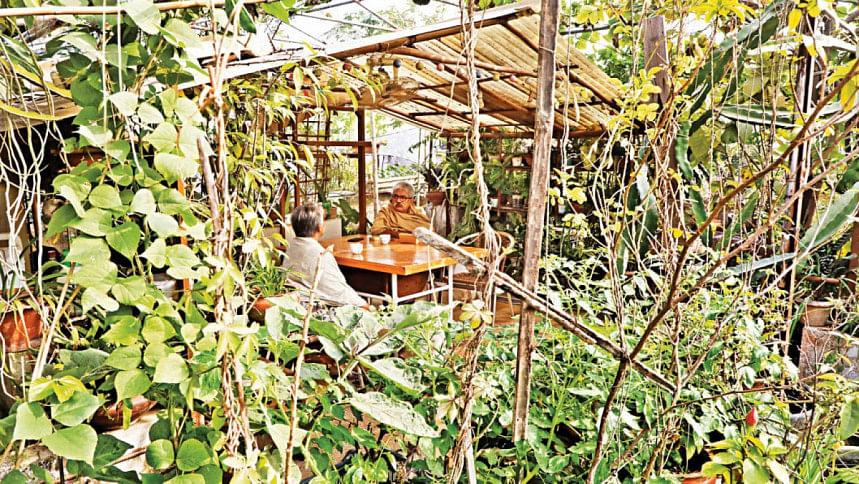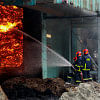Dhaka’s rooftops could feed the city, but law keeps getting in the way

Deep in the heart of Dhaka, where multistorey complexes rise like concrete forests and parks are a luxury, a quiet revolution is taking root: rooftop farming. This is more than just an attractive concept or a design feature—it is a green, sustainable, and urgently needed solution to food insecurity, urban heat, and air pollution. Yet, despite growing interest and even official recognition, rooftop farming in Bangladesh remains legally unregulated and unsupported.
The issue is not a lack of acknowledgement. The National Agriculture Policy of 2018 explicitly references rooftop farming under "Specialised Agriculture." It encourages urban citizens to utilise their rooftops for cultivation and recommends incentives for research and development in the sector. Dhaka North City Corporation (DNCC) has even offered a 10 percent tax rebate to residents maintaining rooftop gardens—a direct cash incentive from the local government.
But recognition does not equate to action. Policies remain fragmented, and the broader institutional and legal frameworks have yet to follow suit.
Perhaps the most significant obstacle is the Bangladesh National Building Code (BNBC 2020). This key document—which dictates how all buildings in Bangladesh must be constructed—fails to mention rooftop farming or green infrastructure even once. There are no guidelines for integrating urban agriculture into building design, no zoning permits, and no regulations mandating that new constructions provide rooftop space for greenery.
Contrast this with cities like Paris, where local building codes require solar panels or green roofs on all new commercial developments. Singapore's Urban Redevelopment Authority (URA) grants Green Plot Ratio bonuses to developers who incorporate rooftop gardens and greenery. Without comparable legal requirements, Bangladesh risks lagging even further behind in sustainable urban development.
Legal hurdles extend further. Even when rooftop farms are operational, they are not recognised as valid food sources. The Food Safety Act (2013), which governs the quality and safety of food products in Bangladesh, fails to categorise rooftop produce as either distinct or low-risk. This legislation was designed for industrial-scale manufacturers, not for families growing tomatoes, lettuce, and herbs atop a four-storey building in Dhanmondi.
As a result, rooftop farmers cannot easily sell their produce through formal distribution channels, despite offering pesticide-free, hyper-local alternatives to chemically grown vegetables sold in open markets. Worse still, the Act has not been updated to reflect the urban agricultural developments encouraged by the National Agriculture Policy. There is no convergence between food regulation and agricultural vision.
Bangladesh has made notable progress in promoting digital agriculture through its National ICT Policy (2018). Initiatives like Krishoker Janala and Balainashok Shohayika deliver real-time information on crop diseases, weather conditions, and best practices directly to rural farmers via digital platforms.
But urban rooftop farmers are excluded. The ICT Policy makes no mention of them. There is no e-commerce integration for rooftop-grown produce, and no extension services available online. Once again, urban agriculture is left out of the conversation.
Then there is the Environment Conservation Act (1995) and its latest update, the Environment Conservation Rules (2023). Despite their importance as cornerstones of Bangladesh's environmental governance, these acts say nothing about the benefits of rooftop agriculture, despite the fact that its environmental value is globally acknowledged.
Green roofs help mitigate urban heat islands, improve air quality, and manage rainwater runoff—all pressing issues for a city like Dhaka. Yet rooftop farming is not officially recognised as an environmentally beneficial practice. It is not exempt from Environmental Clearance Certificates (ECCs), nor is it incentivised. Without being legally identified as a "green activity," there is no justification for promoting or protecting it.
Meanwhile, other countries are adapting their legal frameworks in response to environmental crises. In New York, the Green Roof Tax Abatement Programme offers financial incentives to property developers for installing green roofs. In Singapore, public-private collaborations under the "30 by 30" food security initiative are integrating urban agriculture into everyday life.
The solution is not just policy—it is legal reform. Bangladesh already has elements of a visionary framework on paper. But vision without implementation is just an idea.
The BNBC must be amended to include rooftop farming in building plans and land zoning. The Food Safety Act must introduce streamlined, tiered registration and inspection processes for urban farmers. The ICT policies must incorporate digital tools and support platforms tailored to urban farmers, who are typically younger and more technologically adept than their rural counterparts.
Most crucially, the Environment Conservation Rules must identify rooftop farming as a recognised green initiative—one that enhances climate resilience and deserves institutional support, not neglect.
Rooftop farming is not merely planting; it is about reimagining the urban landscape. In a city like Dhaka, where open spaces are vanishing and rooftops are among the last available urban frontiers, rooftop farming offers an environmentally friendly, democratised and scalable solution.
All it needs is for the law to catch up.
Mir Preom Mosharrof is an LLM candidate at North South University (NSU).
Views expressed in this article are the author's own.
Follow The Daily Star Opinion on Facebook for the latest opinions, commentaries, and analyses by experts and professionals. To contribute your article or letter to The Daily Star Opinion, see our submission guidelines.

 For all latest news, follow The Daily Star's Google News channel.
For all latest news, follow The Daily Star's Google News channel. 










Comments